From Matt:
[Read part one here!]
I think I say some version of this in every conversation I have about gardening: I’m not a great gardener… yet! It has always bothered me that gardening takes so long to learn – you basically only get one chance a year. But reassuringly, all the old timers at the farmer’s market have told me that they barely knew anything when they started as well. It just takes time, and the willingness to work at it.
Here’s what the garden looked like at the end of winter:
The taller plants on the right are actually curly and russian kale that I planted last fall!
They survived the winter (even under a couple snowfalls!) and when the temperature was right they exploded with growth.
I concentrated on this bed first, beginning with pulling up all the weeds and loosening up the dirt with a shovel and hoe. Good to see some healthy signs of life wrigglin around:
I bought four-packs of spinach, arugula, and spring lettuce at the farmer’s market and planted them at one end, and then trimmed up the kale. My hope is that we can still get some edible leaves off the kale without them going to flower too much, but I eventually plan on replacing them with other stuff.
The second bed got the lettuce
As well as some eggplant and peppers.
I planted carrots in this bed the previous fall and man there were still a bunch left!
These were just the good ones – I probably threw out an equal amount of tiny ones that were unusable. We had some for dinner (still delicious!) and made baby food with the rest.
I planted eight different tomato varieties, most of them heirlooms: Mortgage Lifter, Abraham Lincoln, Red Pisa Date, Granny Cantrell just to name a few. Last year I let the tomato plants go wild but I plan on doing a lot of pruning this year. A neighbor of mine always seems to have these small tomato plants that produce a huge amount of fruit, so I got some tips.
I also added in some marigolds, mostly for aesthetics but also for pest-prevention.
Before and after!
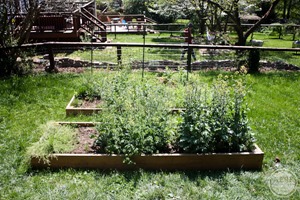
The best advice I have to new gardeners is to not over-extend themselves. I’ve been a victim of this many times – it’s so easy to get excited about gardening at the beginning of the season, but you don’t realize the months of work ahead of you. This garden may look like a lot of space, but if you practice proper plant placement you’ll find that there’s actually not as much space as you think.
I also recommend that people go easy on the fruiting vegetables and concentrate on greens. Greens are SO easy to grow, and produce a huge yield. You’ll really feel like you’re eating your bounty when you have great salads every day. Swiss chard may be the easiest thing ever to grow – you can literally just toss the seeds on top of the soil, lightly rake it around a little, and then water occasionally. I think people get too excited about the idea of having something like unlimited bell peppers for the summer, but they don’t realize that it takes many plants to do this.
A few days after the garden work described above I found some okra sprouts for sale, so I went ahead and removed some of the two kale varieties to make way.
Okra was one of my favorite things I grew last year – just six plants like this produce enough for the two of us to have okra a couple meals a week. Even when they got up to 7’ tall they were still producing great fruit!
One last thing to share – I’ve become a big fan of buying starter plants rather than growing from seed. With things like zucchini, I only need one plant per year, so I might as well pay $2 for the sprout than $2 for the pack of seeds. I don’t want to take up window space in the house to grow seedlings, and I don’t want to spend all my gardening energy early on. So find some good looking plants at your local farmer’s market and save yourself the hassle!
More updates as the garden progresses!


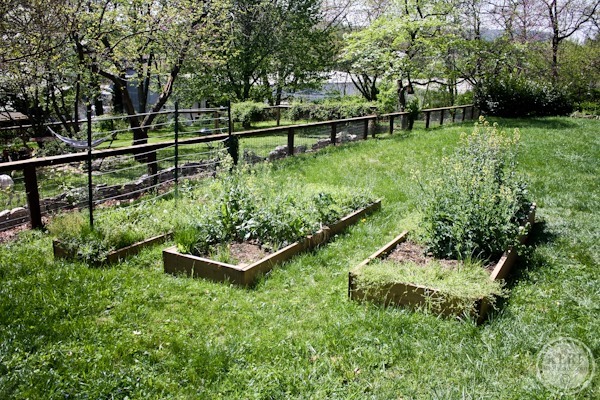
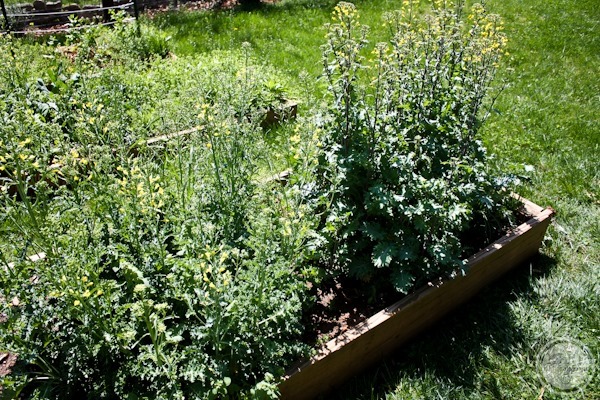
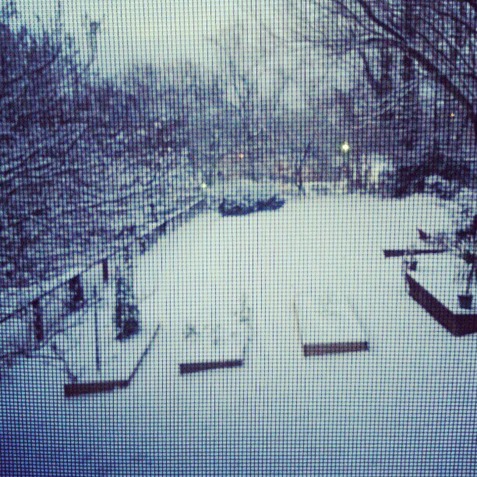
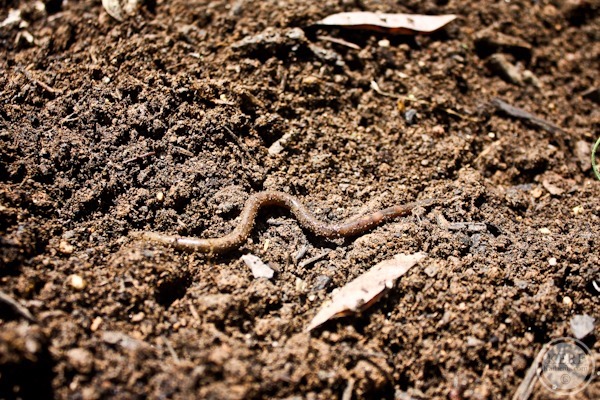
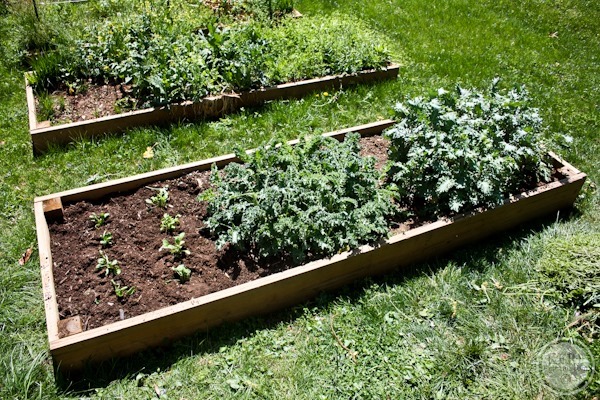
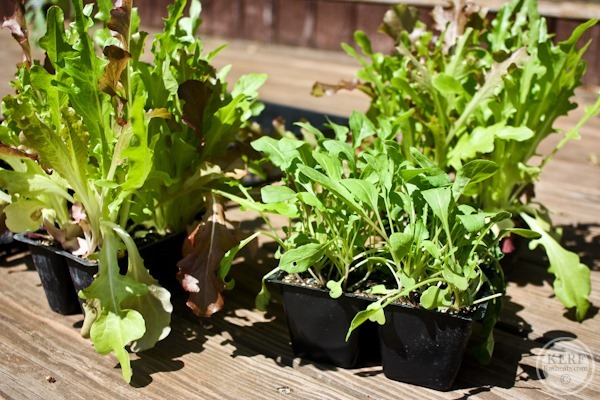
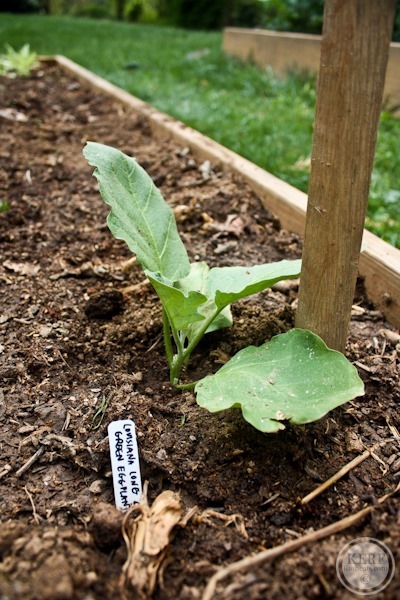
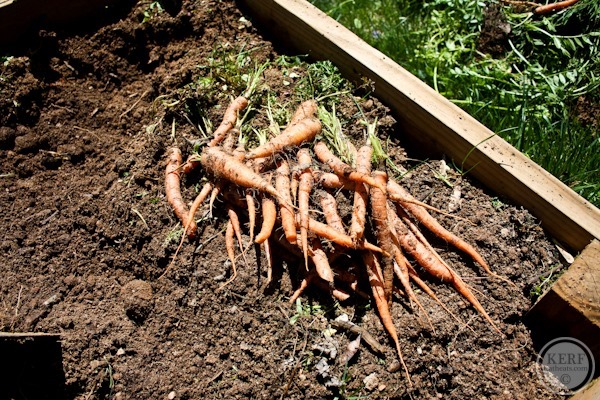
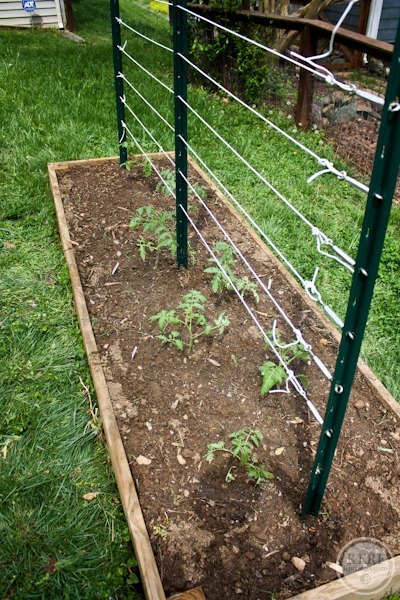
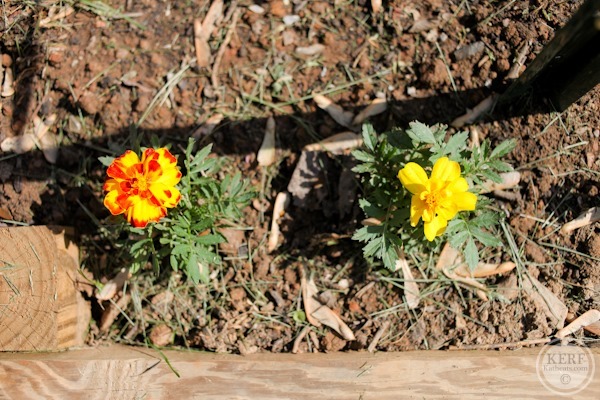
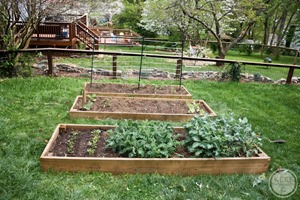
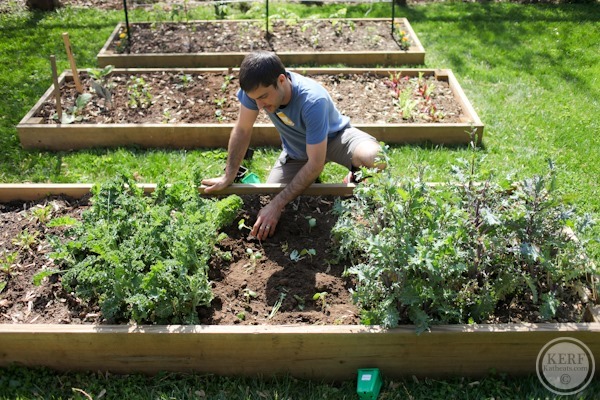
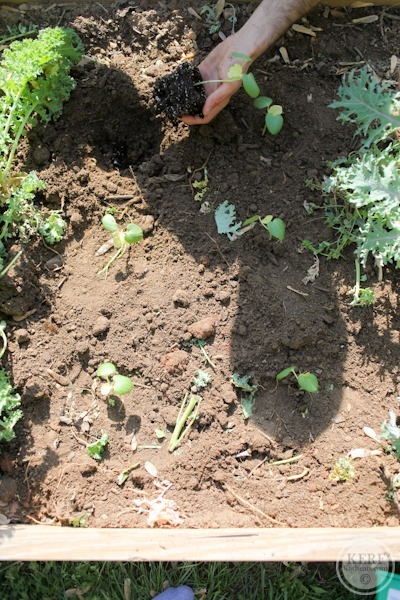
Lauren @ The Hughlands Life says
I just planted my vegetables this past weekend. I love yielding food from my own backyard. But it does seem that my sweet little cucumber plant died. Weird. I’m trudging back to the farmer’s market tomorrow for a replacement. So worth all the cucumbers it yields! I want to grow greens later this fall. I had big plans last fall but a baby was born instead. 🙂
Jane @ Not Plain So Jane says
Wow, nice insider tips. I know when I have the space for a garden I will probably go overboard and try to plant too many things, nice reminder not to get in over my head!
Beth @ Mangoes and Miles says
These are great tips! I think it’d be super cool to grow an okra plant. I’ve only had okra a few times in my life, but it’s so good! I think it’s really cool that you grow your own kale, too. Definitely something I want to experiment with in the future!
Erika @ Balanced Spoon says
Man, this is impressive. I’ve bought two basil plants in the last month, both of which are completely dead. Maybe I need to read a gardening book. Or Kath, is there anyway I can borrow Matt for a couple of days?? haha. 😉 Beautiful garden, I’m jealous!
Becky says
Greens are great to grow spring, fall & winter, but not many greens will take the summer heat here very well, unless they are planted in the shade or replanted from seed frequently – with the exception of Swiss Chard. The money I spend on arugula & kale seeds pay for themselves in no time flat though. I prefer to plant squash from seed because when the bugs get it (as they always do) you just throw a few more seeds in somewhere. The plants for sale are generally less than two weeks old – squash don’t require the amount of starting time & attention that peppers & tomatoes do, which need to be started indoors months ahead of time. I gave up on sweet peppers a few years ago – too much effort for not enough output. One good chile pepper plant has marvelous output though, so I always have one of those. A friend of mine grows all sorts of heirloom & unusual chile peppers, so I get plants from her.
Nate says
Can you tell me a bit more about marigolds for pest prevention? I have been battling caterpillars in my brussle sprouts, I’ve tried many things. The only thing that seems to work is going through a picking them off by hand.
Matt says
I don’t really know too much about it – I just do it because they look pretty and might bring some extra benefit.
Ashli - But What About Protein? says
Great tips! Kale is one of the easiest and most hardy vegetables to grow, and also one of the most nutritious – what a star! 😀 I was guilty last year of growing too many bell peppers – but my friends and neighbors were happy – free bell peppers for all! But really, there is nothing better than being able to walk outside and pick your own veggies for dinner….
Max Sebring says
Thanks for the tips! I am a newbie in gardening so it’s great to learn that greens are so easy to grow. I will concentrate on this and I hope I can a have a fun harvest.
Stacey says
That’s a great point about the $2 for a sprout vs $2 for a pack of seeds. I never thought of it like that? Zucchinis do yield so much fruit from one plant; it’s unreal.
I found it’s best for me to write down garden notes each year so I can go back and compare. I always think I’ll remember and I don’t. I journal the layout, what seed types I purchased, what date I planted, who does well – who doesn’t, etc. This way the next year when I go to buy seeds/sprouts I know which types to avoid and which ones did well for my climate/soil. Works great for me!
Tonya says
ACK! WORM! :-S
Question – I’m a novice balcony gardener and I have a question about how to harvest greens. Do you cut them across like you’re giving them a hair cut or do you pluck the leaves leaving behind a long naked stem? I did the plucking/naked stem last year and I don’t think it’s the right way. I end up with long wiry plucked stalks instead of fat hearty bushes of greens regenerating themselves.
Wish I could upload a visual sketch of what I mean. LOL Hope that was clear.
Matt says
I know exactly what you mean. I kinda do both. In the beginning of the season I give them a haircut. Usually one plant is enough for one salad. Just keep rotating through the group of plants week after week.
But then eventually it does get stemmy and I go with method number two. It’s unavoidable, and my best advice is to cut your losses when it starts tasting bad or having low yield. That means it’s time to plant something else!
Nancy V says
I like kitties, but I am concerned about your neighbor cat using the garden for a litter box? It’s really hard to keep cats out of freshly worked dirt, and once they start using it, they will be back…. Hope you found a good solution for that!
KathEats says
She doesn’t use it for litter regularly – but she does walk through it when Matt is out gardening to keep him company.
Lisa says
I was definitely over ambitious with my garden this year. It took so long to make the garden beds and get the dirt to fill them (we needed a truckload!) that I’ve run out of time to start with seeds. Every year I beat myself up with the fact that I can’t grow everything from scratch, but reading this makes me feel better. I’m going to be buying starter plants instead and I’m going to be happy with that! Thanks Matt!
Emily @ The Sunny Studio says
Thank you for the tip about planting greens rather than “fancy” things like bell peppers in order to get more bang for your buck! I think it would also help me eat more leafy greens in general because they right there in the garden … Craving kale chips now 🙂
Amanda - Small Home Big Start says
Great tips! Thanks for sharing, Matt. Always admire your garden and it’s nice to see that you’re still learning too – I think gardening is one of those things where you can always learn more to help with your yield and even the flavour of your crop.
We did a community garden last year and this year we’re doing a container garden on our apartment porch. Mostly salad greens, herbs, snap peas and tomatoes – nice things to have on hand for salads. Can’t wait until we can have our own backyard and make some raised beds of our own!
Christine @ Oatmeal Bowl says
Lessons learned from my first time gardening: the neighbors will hide from you when you try to bring them zucchini (for the 50th time due to planting 5 zuke plants that yielded a ton!) and you must pinch off some of the flowers or you’ll end up with too many watermelon. In which, none of them will grow successfully because too many are try to suck up the water. by the way, they take a TON of water. hence, ‘water’ melon? 😉
Theodore says
Thanks for posting about the garden beds in particular. I am new into gardening, so I am learning a lot.
Miranda @ Cracked Up Chicken says
We are raised bed gardening for the first time this year. We live in Alabama. I hope our okra turns out.
Karen says
Happy weekend, Kath – Just an FYI: Something funky has been going on with your blog. I can’t scroll down to check out previous posts and once the bar does appear (below your ad) I can’t access the comments function.
KathEats says
I know – I’m troubleshooting : ( I think it’s one of the ads because it’s working at the moment and a different ad is serving. Thanks for letting me know!
Ilane says
Such a helpful post. I would love to have a garden, and now I have a good reference for the future. Thanks! I admire you doing this with having Mazen and the bakery to take care of.
Paula says
I always start my squash and cucumbers from seeds because seeds are so cheap and they last more than a year. In fact my farmers co-op gave away seeds from 2010 last year and I had a bountiful crop of Italian green beans from them. So for me seeds are a better choice for those type vegetable. Same with the okra but I save seeds for them because I plant a variety that isn’t available on the market. It came from my neighbor and it’s a variety that does not need soaking and it can grow very big before getting tough. I think your advice to not overextend is right. Start very small at first. My garden is about 18 by 50 and it’s a huge job to get it planted and weeded and picked. I put up a lot of it in the freezer or canned so it’s really a part time job for me. My husband does NOT garden but he is pretty good at snapping beans so I keep him.
Sarah T. says
I have a huge garden that’s begging for me to clear it out and start planting. I’ve already sprouted some squash plants and plan to do lettuce plants, what else would your reccommend to a first time gardener?
Matt says
Well maters are always the most delicious and you have to learn how to grow them at some point! Just try what you want to eat! Eggplant and pepper are equally easy and there are several varieties.
narami says
This makes me appreciate even more the fact that we can grow all kinds of things all year long over this side of the caribbean, in Puerto Rico. Good earth 365 days: priceless.
Alicia @ Wanna Be Ina says
Is there a post where you discuss the soil in the beds? Did you amend the original soil, or is it all fancy soil that you added to the boxes?
I have to say, I disagree about buying the zucchini and yellow squash plants. Though it’s not a big expense, there is something very gratifying about watching those seeds sprout, and these are by far some of the easiest veggies to grow from seed. Just my opinion though, and not an admonishment for buying the plants.
Matt says
Last year I didn’t do anything to the soil when the beds were first installed. This year I mixed in some light compost. Our compost pile isn’t great. In fact it’s just that – a big pile, mostly of yard scraps and spent grains from brewing. I’d like to build a real pile that can be turned and such… might be a post later this year?
As for buying starts, I’ve learned that I enjoy gardening much more when I make it easier on myself. I agree that it’s really fun to see seeds sprout from nothing, but it’s agonizing to see nothing grow, and then realize you’re now behind on the gardening season. Zucc and squash are definitely good plants to direct sow.